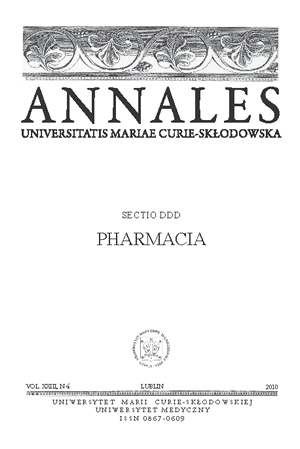The influence of long-term treatment with monosodium glutamate on gastric mucosa in rats
Keywords:
monosodium glutamate, gastric mucosa, water immersion restraint stressAbstract
In acute experiments on 42 white rats we showed that the injection of monosodium glutamate (MG) during 30 days to rats in doses 15 and 30 mg/kg (1 and 2 gram of MG on average statistical person) evoked gastric mucosa (GM) lesions (ulcers, erosions and hemorrhages) and strengthened the stress action on GM. We concluded that the long-term excessive consumption of MG can lead to gastritis and ulcer disease of stomach. Secondly, the maximum daily dose of MG, as well as other food additives must be reviewed with regard to their effect on GM.
References
1. Allen D.H. et al.: Monosodium L-glutamate-induced asthma. J. Allergy Clin. Immunol., 80, 530, 1987.
2. Cao Y. et al.: Purinergic modulation of respiration via medullary raphe nuclei in rats. Respir. Physiol. Neurobiol., 155, 114, 2007.
3. Geha R. et al.: Review of alleged reactions to monosodium glutamate and outcome of a multicenter double-blind placebo-controlled study. J. Nutr., 130, 1058, 2000.
4. Freeman M.: Reconsidering the effects of monosodium glutamate: a literature review. J. Am. Acad. Nurse Pract., 18, 482, 2006.
5. Jezova D. et al.: Endogenous excitatory amino acids are involved in stress-induced adrenocorticotropin and catecholamine release. Neuroendocrinol., 62, 326, 1995.
6. Kwok R.H.M: Chinese-restaurant syndrome. N. Engl. J. Med., 278, 796, 1968.
7. Takagi K. et al.: The effects of drugs on the production and recovery process of the stress ulcer. Japan. J. Pharmacol., 18, 9, 1968.
8. Zelena D. et al.: Simultaneous blockade of two glutamate receptor subtypes (NMDA and AMPA) results in stressor-specific inhibition of prolactin and corticotropin release. Neuroendocrinol., 69, 316, 1999.
Downloads
Published
Issue
Section
License
Copyright (c) 2010 Authors

This work is licensed under a Creative Commons Attribution-NonCommercial-NoDerivatives 3.0 Unported License.


